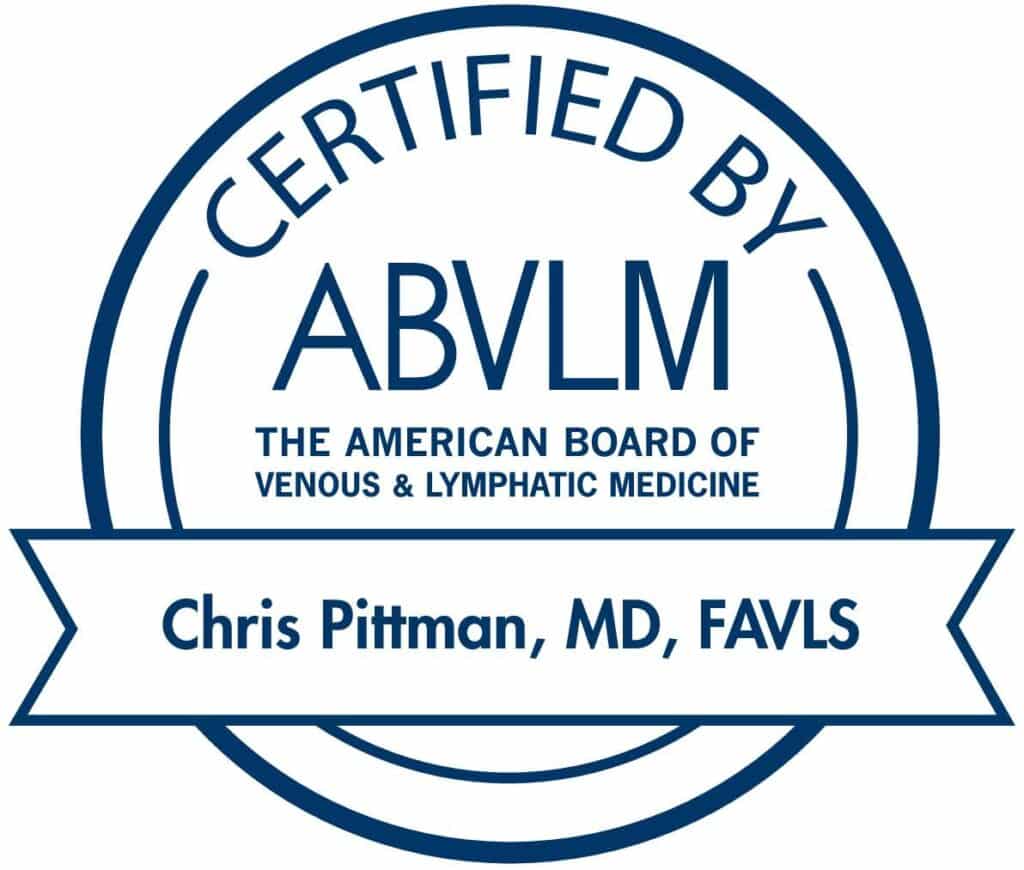
Lipedema is an underdiagnosed disease of subcutaneous fat that affects 10% of women.
There is a disproportionate increase of fatty tissue on the buttocks, hips, thighs, and lower legs, and includes the arms in 80% of cases. Unlike lifestyle-induced obesity, the head, neck, trunk, hands, and feet are spared in lipedema. Those with lifestyle-induced obesity have fat proportionally distributed throughout their body. A lipedema patient has proportionally little fat in their head, neck, chest, waist, hands, and feet.


Common Findings in People with Lipedema
Other Conditions Associated with Lipedema
Hypermobile joints: Joints capable of moving beyond normal limits.
Joint pain: Genu valgum (knock-knees and ankle pronation (flat feet) are common. Early arthritis can be caused by being overweight. Knee replacement may be common.
Lymphedema: Lipedema may result in lymphedema, especially in later stages, called lipolymphedema.
Muscle weakness: Weaker muscles have been demonstrated in lipedema patients.
Obesity: Later stages of lipedema often have superimposed obesity.
Venous Disease: Studies show venous disease and lipedema often co-exist.


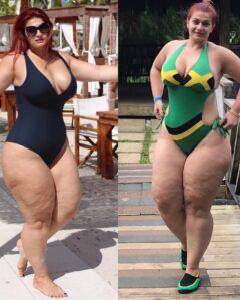
Other Questions for Lipedema Patients
Did your lipedema worsen after surgery or trauma?
Did previous weight loss efforts not affect your buttocks, hips, thighs, lower legs, or arms?
Do other women in my immediate or extended family members look like you?
Anatomical Locations of Lipedema Fat Distribution Are Described as Types
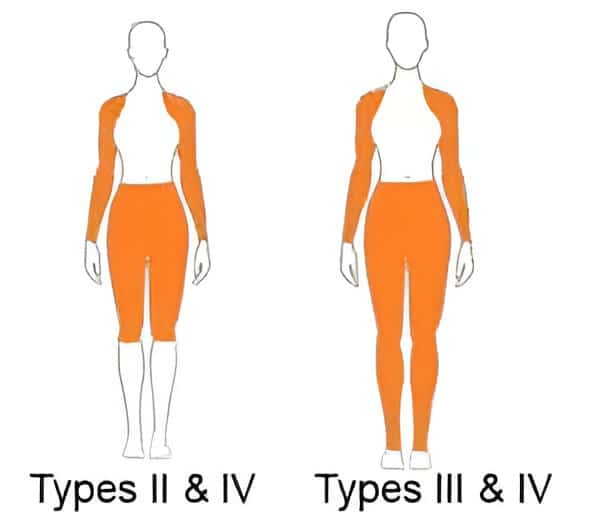

Treatments
Conservative
Diet: Reduce processed carbohydrates and follow the Mediterranean or Ketogenic diet.
Exercise: Movement of any kind is encouraged including whole body vibration, swimming, walking in compression socks, and other low impact activities.
Compression garments: Compression garments reduce pain and improve fluid flow through the tissue while maintaining lower fluid levels after treatments such as manual therapy and pumps. Lower levels of compression leggings can be recommended for people with lipedema with strength of 8-15-25 mm Hg. Class 1 compression for mild venous disease is 20-30 mm Hg. If a person with lipedema has pitting edema or they are able to do so, Class 1 compression should be used. Layering garments is also helpful in lipedema. The stomach should also be treated in people with lipedema.
Sequential Pneumatic Compression Pumps (Pumps): Pumps may be useful for women with lipedema to reduce pain and improve flow through the tissue. Compression garments should be worn after using the pump. Basic pumps can be considered but if only the legs are treated, bike shorts should be worn at the same time. Pumps that treat the abdomen at the same time as the legs (or the trunk at the same time as the arms) include the Tactile Flexitouch PLUS.
Manual lymphatic drainage (MLD): MLD will help some women with lipedema and free fluid in the tissue that is unbound but bound fluid is hard to reduce with MLD alone. Seek deeper techniques to help reduce fibrosis in the tissue. Therapists are physical therapists (PT, Occupational Therapists (OT) or licensed massage therapists (LMT).There are certified lymphedema therapists.
Treatment of Venous Insufficiency or Varicose Veins: There may be no immediate improvement in symptoms but over time there may be a reduction in progression of lipedema.
Supplements
There are no supplements specific for lipedema.
Diosmin: Diosmin comes from the rind of citrus fruit and is known to reduce inflammation around veins and improve lymphatic pumping. Some lipedema patients notice reduced pain and improved heaviness of their legs after taking the brand name of this supplement, Vasculera.
Meriva: Turmeric or curcumin are good anti-inflammatory supplement. Meriva is a highly absorbed, sustained-release form of curcumin.
Medications
There are no medications that are specific for lipedema.
Metformin: Metformin is an anti-inflammatory medication that can prevent and reverse fibrosis.
Sympathomimetic Amines: Sympathomimetic amines such as phentermine or dextroamphetamine, medications used for the treatment of obesity, may also help in reducing fat and improving lymphatic pumping in people with lipedema.
Medications to Avoid
Medications that cause edema: Gabapentin and Amlodipine are common medicines that may cause ankle swelling.
Diuretics: Diuretics do not treat the main cause of edema in lipedema which is inflammation. Diuretics concentrate protein in the interstitial space which then draws in more fluid.
Surgery
If a woman with lipedema fails conservative therapy and other measures, including bariatric surgery to reduce lipedema tissue, then lipedema reduction surgery is an option. Lipedema reduction surgery is usually accomplished using tumescence and suction lipectomy (liposuction) or water jet assisted liposuction (WAL). Providers that know lipedema should be chosen over providers that know liposuction but do not have experience treating patients with lipedema.
Some insurance companies are now covering lipedema reduction surgery. Ask your Vein911® Vein Treatment Centers Vein Care Specialist for the names of the best Lipedema surgeons in the USA.
Stages of Lipedema
Stage I
- Skin is smooth, flat with enlarged subcutis
- Swelling increases during the day and may resolve with rest and elevation
- Responds well to treatment
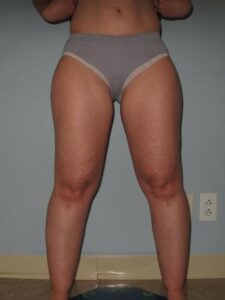
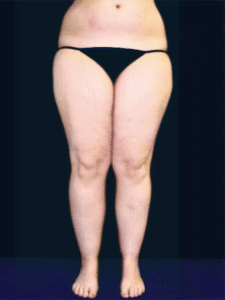
Stage II
- Skin has walnut or apple sized indurations with an overlying “mattress” appearance
- Lipomas may develop
- Eczema and erysipelas may be present
- Swelling increases during the day, with less resolution after rest and elevation
- May respond well to treatment

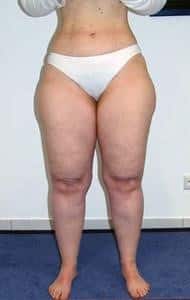
Stage III
- Hardened connective tissue/fibrosclerosis; larger indurations and/or deforming fat deposits (lobular)
- Swelling consistently present
- Large masses of skin and fat that overhang
- Less responsive to some treatment modalities
- Less responsive to some treatment modalities
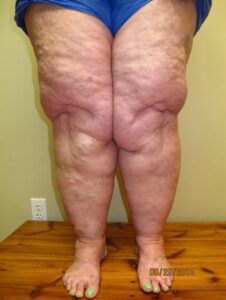
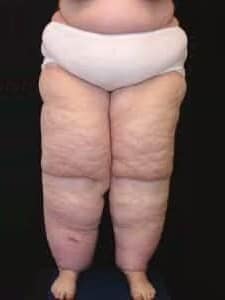
Stage IV
- Fibrosclerosis, possibly elephantiasis; lymphedema occurs
- Swelling is xconsistently present; legs can become stiff
- Larger masses of skin and fat that overhang
- Also known as lipolymphedema
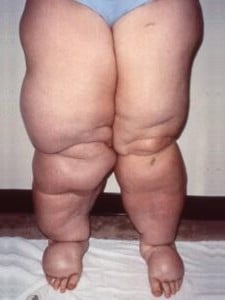
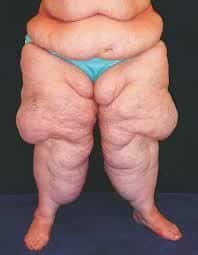
Resources
Vein911® Vein Treatment Centers Lipedema YouTube Videos
Lipedema Foundation
Fat Disorders Resource Society
Advanced Lipedema Treatment — Dr. Karen Herbst, PhD, MD
If you think you may have lipedema, call us today! (813) 544-8715
Vein911® Vein Treatment Centers Vein Care Specialists are experts in diagnosing lipedema in Tampa, Florida and we will share with you the best ways to treat lipedema including referral to the best lipedema surgeons in the United States and Europe, if indicated.










